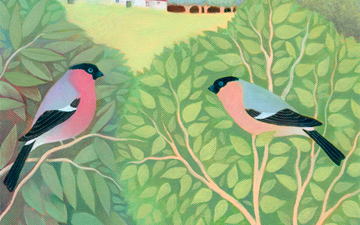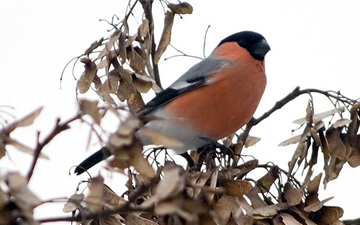The Bullfinch, Common Bullfinch or Eurasian Bullfinch, Pyrrhula pyrrhula, is a small passerine bird in the finch family Fringillidae.
This bird breeds across Europe and temperate Asia. It is mainly resident, but many northern birds migrate further south in the winter.
Mixed woodland with some conifers is favoured for breeding, including parkland and gardens. It builds its nest in a bush, (preferably more than 4 metres tall and wide),mature stands of scrub, or tree, laying 4-7 eggs. The food is mainly seeds and buds of fruit trees, which can make it a pest in orchards. If wild bird cover is planted for it, Kale, Quinoa and Millet are preferred, next to tall hedges or woodland.
This species does not form large flocks outside the breeding season, and is usually seen as a pair or family group.
The Bullfinch is a bulky bull-headed bird. The upper parts are grey; the flight feathers and short thick bill are black; as are the cap and face in adults (they are greyish-brown in juveniles), and the white rump and wing bars are striking in flight. The adult male has red underparts, but females and young birds have grey-buff underparts. The pleasant song of this unobtrusive bird contains fluted whistles.
(From Wikipedia, May 17th, 2010)
– – –
Bullfinches have a broad diet, consisting mainly of the seeds and berries of a variety of plants. When these are scarce during the spring they turn to the buds of fruit trees. When bullfinches occurred in higher numbers they were considered to be pests of orchards. Nests are built in dense hedges and woods between four and seven feet from the ground. Fine twigs, moss and lichens are used to construct the main body of the nest and a lining of fine roots is added. In May 4-5 pale blue spotted eggs are laid, the female incubates the eggs for 12-14 days after which both parents feed the chicks. A further 12 to 16 days later the chicks fledge. A second brood is then usually produced (3).
(From EOL via ARKive)
– – –





